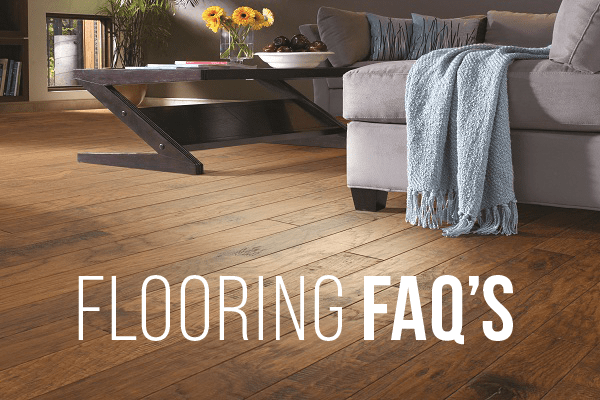The Most Common Flooring Questions
Picking the right floor for your home is no easy task. Picking the right product, type, and style can depend on your needs, your preexisting decor, and your own personal taste. That’s why it’s important to be as well-informed as possible through all steps of the floor buying process. With so many variables in the process we thought we’d share some helpful FAQ’s (frequently asked questions) and answers below.
What’s the difference between berber, frieze and plush carpeting?
These are types of carpet textures. They have little to do with the equality of carpet. Berber typically refers to carpet that is looped – it’s beginnings predate modern methods of mass producing carpet and shearing it to produce cut-pile carpet, also called plush. Berber was made on looms and often knotted into rugs. Frieze, and another similar type called textured plush, is simply plush carpet that has been twisted and set with heat in order to achieve a casual, “nubbier” texture. All of these textures are made across the entire spectrum of products from inexpensive, economy grades up to the very expensive.
Is there a certain type of urethane finish that I must look for in a new hardwood?
More and more homeowners are choosing to purchase hardwood flooring because it has become increasingly affordable. Today, most better quality, prefinished hardwood products offer superior finishes and chemical treatments that, in many cases, significantly delay the need for sanding or extensive maintenance processes for many years. A very popular treatment applied by most hardwood mills is aluminum oxide which is a part of the urethane – this makes the flooring much harder and resistant to minor abrasions. The trend in finishes continues to be toward delustered, low-gloss styling. These designs add authenticity and are reminiscent of older hardwoods and the way quality planks used to be finished.
Solid hardwood, engineered, or laminate – which is best?
Hardwood flooring’s hardwood flooring, right? Take a tree, cut it down, put some varnish on and put it on the floor. Isn’t that how it works? Maybe once upon a time. But when you go shopping for hardwood floors, you may find yourself bewildered by all the different types of flooring available. There’s solid hardwood floors, engineered hardwood floors, laminate floors. Is it all real wood? What’s going to work best for your home? Relax, we’ve got answers.
Laminate
Laminate flooring is not wood flooring. It is comprised of all synthetic materials, very much like mica countertops. And this makes laminate extremely resistant to scratches, dents, scrapes, etc. it is very desirable for young active families for this reason – and because it can be 20%, 30% or 40% less than hardwood flooring. Laminate often uses a photo that is printed onto to a melamine core. Today, in many styles the core and top layer are texturized to match the register of the printed image and this creates a board that, to some people, is almost indistinguishable from real hardwood.
Engineered Hardwood Flooring
Engineered hardwood is made in layers. Each layer under the top layer is laid perpendicular to the one below. When conditions such as temperature or humidity change engineered hardwood tends not to distort or react since each layer offsets the expansion or contraction of the layer(s) below or above. Because of this stability, engineered floors can be installed below, on, or above grade and they can be floated (over existing flooring), glued or nailed. Because this type of hardwood flooring is so versatile it has become the preferred choice of most homebuilders and remodelers. It represents over 50% of the U.S. hardwood sales. Generally engineered floors are essentially indistinguishable from solid hardwood floors when properly installed.
Solid Hardwood Flooring
Solid hardwood flooring is, as its name implies, a solid board. There are no significant advantages to selecting solid over engineered hardwood flooring, however most people who grew up with solid simply prefer it. One misperception about solid hardwood flooring is that it can be sanded and refinished an unlimited number of times. For virtually all nail-down solid installations this is not true. Although 2 ¼” and 3 ¼” were the standard widths for many years, solid styles are now made with updated stain colors and in wider widths such as 4” and 5”.
If you have the info you need, you’re ready to take your next step in the flooring process. Contact us today at 879-TISH (8474) to schedule a free in-home consultation, day or evening, weekday or weekend, and we’ll bring flooring samples straight to your door.


